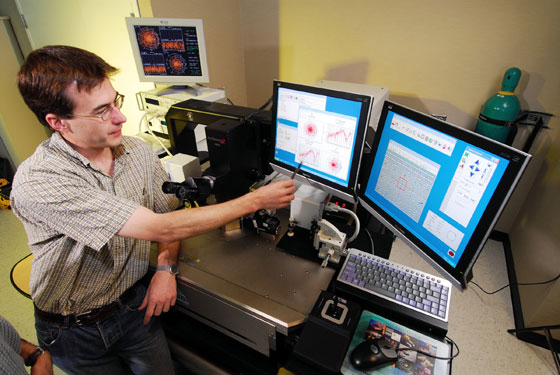In a study conducted at the Georgia Institute of Technology, the researchers tried different radio frequencies in order to replace cables for data, audio and video transmission and managed to reach a speed of 15 gigabits per second ● In their estimation, the technology will be available to everyone within two to three years
Avi Blizovsky, The People editor, DailyMaily

Prof. Steven Finnell, a researcher at the Electronic Design Center of the School of Computer Science at the Georgia Institute of Technology, demonstrates the network
Researchers from the Georgia Institute of Technology, USA, reported at the end of the week that they managed to eliminate the tangle of wires familiar to every military officer, which fills the computer rooms with a huge "spaghetti" - and replaced it with a wireless connection configuration. In a study conducted at the Electronic Design Center of the School of Computer Science at the Georgia Institute of Technology, researchers tested different radio frequencies with the goal of replacing data, audio, and video cables. The researchers were able to achieve a data transfer rate of 15 gigabits per second at a range of one meter using radio waves at a frequency of 60 gigahertz. Since in the USA there is no need for a license to use this frequency range, the researchers can use it as they wish. In experiments conducted in the laboratory, the researchers were able to transmit data at a rate of 10 gigabits per second for a distance of two meters and 5 gigabits per second for a distance of five meters.
"Within three years, the wireless multi-gigabit approach will be able to serve the next generation of personal networks, including for use at home to transfer multimedia files from the computer to various screens at home in high definition (High Definition) and to transfer an entire DVD in seconds," said the project's chief researcher, Prof. ' Steven Finnell. According to him, a network like the one developed at the university could enable the distribution of home or office systems in a much more convenient way than is customary today.
According to Prof. Pinel, "the results of the research represent a huge leap in the capacity that has been possible so far. At speeds of 10 Gbps, you can download a DVD to your cell phone in 5 seconds. The input/output systems of these devices are no longer able to reach such speeds, but thanks to them it will be possible to connect wirelessly to any device that currently uses a FireWire or USB connection."

2 תגובות
As I understand the matter (and I may be wrong), the transmission power is not related to the wavelength of the radiation (or the frequency).
It is true that the higher the frequency of the radiation, the higher the energy of the electromagnetic wave (and the more dangerous the radiation), but it is possible to transmit radiation with the same frequency at different intensities (the power is different).
An example of this is the antennas of the cellular companies that transmit at a very high power (therefore they are much more dangerous than the cell phone transmitter) but still in the RF frequency range.
Therefore, what changes is the average transmission power of the radiation that will be used to transmit the information compared to the average transmission power of the cell phone.
It seems to me that the electromagnetic radiation of technology is dangerous.
Is it wrong to think that if the radiation frequency used by cell phones is about 50 times smaller, more or less, than the radiation of the aforementioned technology, then the amount of electrical power per kilogram of weight (SAR) is also many times smaller?
That is, my question is, is the radiation of the device that works regularly more dangerous than a cell phone that works not regularly?